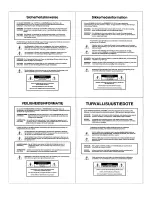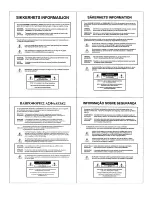
2
CONNECTIONS
remote control
power
logic inputs
link port
link
serial port
50/60 Hz
~
27V
12 watts
class 2
wiring
BIAMP SYSTEMS
Portland, Oregon
an affiliate of Rauland-Borg Corp.
RCU
AC Power Cord:
The power transformer provides 27 Volts AC to
the RCU, and is detachable via a 5-pin DIN connector. The RCU
has two internal ‘self-resetting’ fuses (there are no user
serviceable parts inside the unit). If the internal fuses blow, they
will attempt to re-set after a short period. However, this may be an
indication that the RCU requires service.
Serial Port:
This 9-pin Sub-D (male) connector provides an RS-
232 Serial Port for control of the RCU (and associated products)
via computers or third-party controllers (see RS-232 Control on pg.
10). The Serial Port has the following pin assignments (left-to-right
& top-to-bottom):
Pin 1)
not used;
Pin
2)
Receive Data (RxD)
input;
Pin 3)
Transmit Data (TxD) output;
Pin 4)
Data Terminal
Ready (DTR) output;
Pin 5)
Ground;
Pin 6)
not used;
Pin 7)
Request To Send (RTS) output;
Pin 8)
not used;
Pin 9)
not
used. PC Control Software and a serial cable are provided for
programming via Windows
®
95 (see Setup on pg. 4).
NOTE:
The
Serial Port also transmits commands assigned to external
potentiometers & contact-closures (see Remote Control & Logic
Inputs below).
Link Port:
This 9-pin Sub-D (female) connector provides a Link
Port for RS-232 control from the RCU to other ADVANTAGE
®
programmable products (see RS-232 Control on pg. 10). The Link
Port of one device simply connects to the Serial Port of the next
device (and so forth). Link cables are available as an option
(Biamp #909-0057-00).
NOTE:
All but the final device in a system
should have the Link Switch pressed in (see below)
. The Link Port
has the following pin assignments (right-to-left & top-to-bottom):
Pin 1)
not used;
Pin
2)
Transmit Data (TxD) output;
Pin 3)
Receive Data (RxD) input;
Pin 4)
not used;
Pin 5)
Ground;
Pin 6)
Data Set Ready (DSR) output;
Pin 7)
not used;
Pin 8)
Clear To Send (CTS) output;
Pin 9)
not used.
NOTE:
The Link
Port also transmits commands assigned to external potentiometer
& contact-closures ( see Remote Control & Logic Inputs below).
Link Switch:
The Link Switch is used when connecting multiple
devices in a ‘Link Port to Serial Port’ configuration (see Link Port
above). From the factory, the Link Switch is released (out). When
connecting multiple devices, the Link Switch must be depressed
(in) on all devices except the final device in the system (the device
with no Link Port connection).
Remote Control:
This 25-pin Sub-D (female) connector allows
connection of up to 23 potentiometers (on pins 1~23 respectively),
with a common control voltage (+5 Volts DC on pin 24), and a
common ground (on pin 25). Potentiometers should be between
5k ohms and 50k ohms in value, with a linear taper (see Controls
on next page). Potentiometers are wired with high to +5 Volts (pin
24), low to ground (pin 25), & wiper to the desired control terminal
(pins 1~23). Each potentiometer may be programmed to control a
specific function on a specific product (see Setup on pg. 4). These
functions typically include various level adjustments.
Logic Inputs:
This 25-pin Sub-D (female) connector allows
connection of up to 24 contact-closures (on pins 1~24 respectively)
with a common ground (on pin 25). Contact-closures may be
switches, relays, or logic outputs from other devices (see Controls
on next page). Each logic input may be programmed to control a
specific function on a specific product (see Setup on pg. 4).
These functions typically include muting, source selection, & preset
selection. However, logic inputs may also be programmed to
enable/disable potentiometers or other logic inputs, as well as to
transmit custom ASCII characters commands to other products.
Power Indicator:
When the power transformer is plugged in, and
AC power is applied to the RCU, the Power indicator remains lit.




































